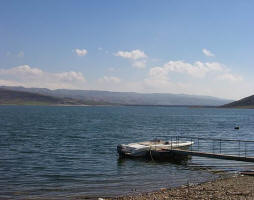 Mainstreaming climate prediction into water management crucial
Mainstreaming climate prediction into water management crucial
Key sectors such as agriculture, energy, tourism and health will be among those most affected by the impact of climate change on water resources, for example, reduced water availability, a deterioration in water quality, increased runoff and an increase in the salinization of groundwater as a result of sea-level rise. “Mainstreaming climate change in decision-making processes will therefore be central to all development and poverty alleviation efforts”, emphasized the Secretary-General of the World Meteorological Organization (WMO), Mr Michel Jarraud, today when he addressed the thirteenth World Water Congress, being held from 1 to 4 September in Montpellier (France).
There is a need to update land and water resources development strategies and economic planning through approaches such as integrated water resources management, integrated flood management and watershed management. In view of competing demands and the need for inter-sectoral planning, water resources managers require accurate and reliable climate information, which is not always readily available at present.
Therefore, WMO has launched an appeal for funding to set up hydrological information systems that can provide timely, accurate and comprehensive water resources information. The capacities of developing countries must be strengthened in this area. Mr Jarraud said that there was a growing need for the wider international exchange of hydrological data and products.
Among the many challenges to be met, Mr Jarraud referred to the problem of access to water by society, which has increasing demands. Water resources will be affected by the decrease in groundwater, in particular in rural areas, on small islands and in regions that depend on water from snowmelt and glaciers, which represent one sixth of the world population. Drinking-water intakes in many cities may be adversely affected by lower low flows or sea-level rise. Mortality rates for water-borne diseases, such as cholera or malaria, will increase in the wettest and driest scenarios.
Because of precipitation variability, there is a need to develop and optimize the use of irrigation in food production. At the local level, the use of irrigation in agriculture may, however, present additional challenges linked to variations in spatial and temporal streamflow distribution. Furthermore, the economic and social pressures envisaged for the coming decades may further increase the competition for water resources between food production and other agricultural sectors, including that of the growing production of biofuels. Hydroelectricity, a renewable energy source, will be increasingly affected by changes in river discharge.
To address the needs of decision-makers, WMO has taken action to promote the provision of climate information to develop adaptation strategies for various sectors at the national and regional levels and to ensure that these strategies are reflected in national development plans.
The World Climate Conference-3, which will be held in Geneva from 31 August to 4 September 2009 with the theme of climate prediction and information for decision-making, will be a major event. This Conference should lead to concrete results in terms of improved inter-sectoral coordination, progress in the field of climate prediction and in social and economic fields, in particular for natural disaster prevention.
| Contact information |
Ms Carine Richard-Van Maele, Chief, Communications and Public Affairs, WMO./ Ms Gaëlle Sévenier, Press Officer
(email: cpa@wmo.int ; ) Phone: +41 (0)22 730 83 15 / +41 (0) 22 730 841 |
|---|---|
| News type | Inbrief |
| File link |
http://www.wmo.ch/pages/mediacentre/press_releases/pr_827_en.html |
| Source of information | World Meteorological Organization (WMO) |
| Keyword(s) | climate change, river discharge |
| Subject(s) | AGRICULTURE , ENERGY , FINANCE-ECONOMY , POLICY-WATER POLICY AND WATER MANAGEMENT , RISKS AND CLIMATOLOGY , TOURISM - SPORT - HOBBIES |
| Geographical coverage | International |
| News date | 11/09/2008 |
| Working language(s) | ENGLISH |
 you are not logged in
you are not logged in





